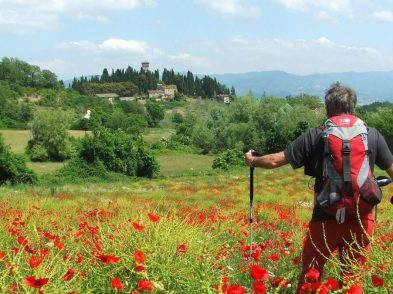Imagine a place inhabited since the Stone Age, the site of an ancient Etruscan metropolis whose population exceeded 25,000 people hundreds of years before Christ set foot on the earth. Conquered by the Romans, the Lombards, the Franks, and the Florentines, this is a town which inspired Dante, Boccaccio and D’Annunzio. It’s a place where the past is tangible and the present inexorably fades away into the background. This place is Volterra.
In Volterra, which is located 48 miles to the southwest of Florence, the passing of time is well evident: century after century, civilization after civilization, layer upon layer. Yet, paradoxically, the hands of time seem to have stopped turning there since the Middle Ages. D.H. Lawrence’s description of the town can be helpful to understand this paradox: ‘it gets all the wind and sees all the world—a sort of inland island’. Perched on a hilltop dominating a vast area, Volterra owed its fortune to its strategic position. Volterra is still a medieval town in pristine condition, preserved by sheer luck, like a frozen mammoth.
Velathri, its Etruscan name, was the northernmost city of Etruria, a confederation of 12 Etruscan cities. The once prominent town is still surrounded by its massive medieval walls and one of its gates, la Porta all’Arco, was part of the even longer defensive wall built by the Etruscans in the fourth century B.C. The Porta all’Arco is an archway some 20 feet high, crowned by three enigmatic heads carved in stones. They are thought to be the ancient guardian deities of the city, but they could also be warning signs, since the Etruscans used to behead their enemies.
The Guarnacci Museum in Volterra is one of the best places to catch a glimpse of the Etruscan civilization. It boasts an impressive collection of Etruscan jewellery, ceramics, bronzes and funeral urns. Local craftsmen make beautiful alabaster sculptures, which are on sale in workshops and stores at very affordable prices. A famous exhibit, part of the Guarnacci Museum’s collection, is the Shadow of the Night, a 22-inch bronze male figure, mysteriously elongated, hence its name. It was originally thought to be a deity, then a votive figure, offered to the deities as a form of gratitude. Other experts consider the figure to be a Lari, a friendly spirit who protected hearth and home. It has a solemn and authoritative look, and its thin silhouette is in striking contrast with the buxom bodies carved on Etruscan sarcophagi.
The highest place in town, where the acropolis once stood, is now occupied by an archaeological park whose main attractions are the remnants of two Etruscan temples and a fascinating Roman cistern, known as the Piscina, built to collect rain water which was later distributed to citizens living in lower-lying areas. A magnificently preserved Roman theatre, located just outside the walls, is the most eloquent testimony to the Roman domination of Volterra. The theater was built in the first century B.C. and was not discovered until 1950. During the Middle Ages, it served as a garbage dump, and it is comforting to know that now it hosts an important summer festival. Direct descendants of affluent Roman era’s theatre-goers could, in theory, claim the right to sit in the front rows, since some of their names, carved in stone, can still be read.
Volterra has the typical aspect of a medieval town, with cobbled streets, narrow, sinister-looking alleys, splendid palaces, shaded corners, and a large number of churches. Two adjacent but separate squares, Piazza dei Priori and Piazza San Giovanni, symbolize temporal and religious power, respectively. The latter is dominated by the 12th-century Romanesque cathedral, where a number of priceless works of art can be admired. In front of the cathedral stands the baptistery, an octagonal building with a white and green marble façade, whose dome resembles that of Florence’s cathedral and is said to have been designed by Brunelleschi.
In the early Middle Ages, Volterra, which is still Episcopal see, was under the bishop’s rule, and Palazzo dei Priori was built in the 13th century to celebrate the birth of the free commune. The palace, located in the square with the same name, is the most ancient town hall in Tuscany, and Florence’s Palazzo Vecchio was modelled after it. The second floor of the building houses the civic art gallery where Renaissance masterpieces are on display, most notably the Deposition from the Cross by Rosso Fiorentino. Daniele da Volterra’s works are also on display. He is known as ‘the pants painter’ because he ‘dressed’ Michelangelo’s nudes inside Rome’s Sistine Chapel. Other decorations include the Florentine coat of arms, which are a reminder of the period when Volterra was under Florence. The two lions guarding the entrance are a symbol of Florence as well and were added in 1472. An enlargement of Volterra’s 14th-century castle, commissioned by Lorenzo il Magnifico, dates back to the same period. This beautiful castle, which stands near the archaeological park, today serves as a prison, and its crenulated walls play the double role of preventing escapes and enhancing Volterra’s skyline.
For further information about Volterra, contact Consorzio Turistico Volterra





